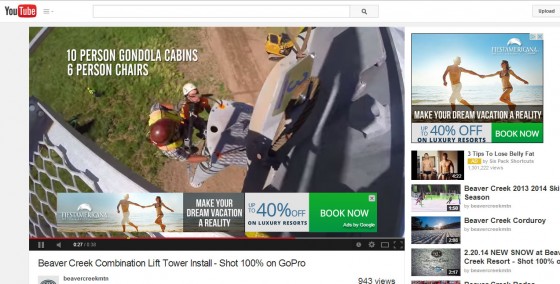Video
When I talk about embedding videos instead of linking to YouTube, this is a big reason why.


BLANCHARD
I tweeted this yesterday but, with a desire to emphasize the point with more than 140 characters and a last-minute hole in the content schedule, wanted to point it out again.
A while back I wrote a surprisintly controversial post about embedding rather than sharing. The core of the idea was:
Instead of sharing links to these sites, I’d start to embed all of my YouTube and Vimeo videos, photos and Instagrams, Vines and TwitPics onto my website in a blog post (one for each piece of content) and sharing the link to that post instead.
Had I stopped at just YouTube videos (and your own YouTube videos as that), perhaps my point would have been clearer, but I wanted to highlight the fact that resorts generate a ton of traffic through their social accounts.
Much of that traffic goes to sites that are totally willing to let the sharer get the traffic instead by using embed codes.
The Reasons
There are a lot of reasons for a resort (or any brand) to embed videos on their own site and sharing that link instead.
But at the core of all of these reasons is the fact that you now have control over what surrounds the content. Which means you have control over what is most likely to be their next step.
The tweet I referred to yesterday is a simple example of this. Here’s Beaver Creek’s video:
And here’s Beaver Creek tweeting a link to that video:
All 25 Combination lift towers are in place! See some of the construction on GoPro here: http://t.co/2dJRA2nGks
— Beaver Creek Resort (@beavercreekmtn) July 21, 2014
But here’s how that video looked on YouTube when I (and about 100 other people) clicked on that link.
On top of and to the side of that video were banners advertising offers for Beaver Creek’s competitors.
Even if the ad on the video remained (and YouTube has given you some control over that), if someone watches this on Beaver Creek’s site instead of YouTube’s, the rest of the content would have overwhelmed the influence of the banner in favor of the resort: moving them closer to Beaver Creek’s goals instead of YouTube’s or a competitor’s.
Another Angle
Let me put this another way.
Since last summer, ski resorts have shared 11,244 links to YouTube and Vimeo videos on Facebook and Twitter. If they had embedded those on their websites and shared that link instead, an average of 50 clicks per link would have given resort an extra 562,200 website visitors.
If we believe in the value of website traffic (and perhaps a lack thereof is the issue), I hope the value of this is clear. Because even with a sorrowfully low conversion rate, that much traffic equals a boat load of lost opportunity.
About Gregg & SlopeFillers
I've had more first-time visitors lately, so adding a quick "about" section. I started SlopeFillers in 2010
with the simple goal of sharing great resort marketing strategies. Today I run marketing for resort ecommerce and CRM provider
Inntopia,
my home mountain is the lovely Nordic Valley,
and my favorite marketing campaign remains the Ski Utah TV show that sold me on skiing as a kid in the 90s.
Get the weekly digest.
New stories, ideas, and jobs delivered to your inbox every Friday morning.

